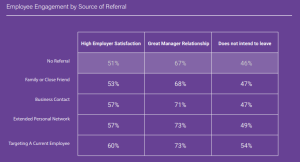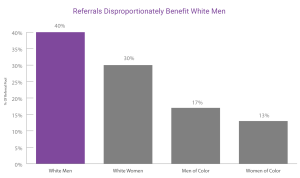From my desk I can see the impact that employee referrals have on hiring: Four members of our 12-person team received some kind of referral for their position. This may seem anomalous, but PayScale’s research shows that our team is representative of the overall labor market since over a third of all workers received some kind of referral for their current job.
As referrals are probably only going to become more common, understanding how people get referred and how referrals impact your company is paramount to creating a workforce that works for you.
How people get referred
Between April 24, 2017 and August 25, 2017, PayScale asked 53,000 workers if they had received an employee referral at the company at which they currently work. For those who were referred, we also asked for the source of their referral. We found that the most common type of referral was from a family member or close friend (41% of employees who received a referral), followed by a business contact (32%). Leveraging extended personal networks (i.e. a friend of a friend) was less common but was still used by 22% of all referred employees. Targeting current employees to seek a referral was the least common, but 5% of referred workers managed to work these cold contacts into jobs.
Referrals rates by industry
While 34% of employees across all industries received a referral, some rely on them more than others. On the low end ar e the retail and customer service industry, along with health care and social assistance, with only 31% of workers receiving referrals. The construction industry, on the other hand, is built on referrals. Not only is the referral rate 5 percentage points higher in the construction sector than in the economy as a whole, it is a full 2 percentage points higher than the industry with the next highest referral rate. In addition, referrals by family members or close friends are notably higher in construction than in any other sector.
e the retail and customer service industry, along with health care and social assistance, with only 31% of workers receiving referrals. The construction industry, on the other hand, is built on referrals. Not only is the referral rate 5 percentage points higher in the construction sector than in the economy as a whole, it is a full 2 percentage points higher than the industry with the next highest referral rate. In addition, referrals by family members or close friends are notably higher in construction than in any other sector.
In recent years, tech companies have been heavily scrutinized for relying on personal connections and referrals in hiring. However, our data show that the use of referrals in tech is in line with most other industries, falling in the middle of the pack when we look at the percentage of employees who had a referral. Referrals from business contacts as well as from extended networks appear to be slightly higher than average, but overall the tech industry does not differ greatly from the other industries we analyzed. It seems that the backlash against tech companies is overblown, at least when it comes to relying on referrals.
Referrals lead to higher levels of engagement
Similar to other research, we find that referred employees are more engaged. They are more likely to report that they are satisfied with their employer and that they have a great relationship with their manager. They are also less likely to say that they intend to leave within six months.
Referred employees tend to be more engaged, but the size of that impact depends on the source. Employees who received a referral from their extended network or from targeting an employee are the most engaged workers. Unsurprisingly, people who make a concerted effort to find someone at a company to get a referral are likely those who are most excited about the company, its mission and its culture.
On the other end of the spectrum are people who received referrals from a family member or close friend. While they still have better engagement outcomes than those who did not receive a referral, they do have notably lower levels of satisfaction with their employer and worse relationships with their managers than other referred employees. They are tied with those who received a referral from a former business contact for having the highest rates of saying that they intend to leave within six months.
So, the next time a stranger messages you on LinkedIn because they are excited about your company, think twice before ignoring them.
White men benefit most
Given that referrals can lower recruitment costs and lead to better outcomes for workers and employers when it comes to employee engagement, it seems like a no-brainer that companies should try to take advantage of referrals as much as possible when hiring. Unfortunately, there is an ugly side to referrals: they benefit white men more than any other demographic group.
Our research shows that, holding all else constant, women of any race and men of color are much less likely to receive referra ls than their white male counterparts: white women are 12% less likely; men of color are 26% less likely and women of color are 35% less likely to receive a referral.
ls than their white male counterparts: white women are 12% less likely; men of color are 26% less likely and women of color are 35% less likely to receive a referral.
To put it another way, given the current demographic composition of the labor market, if you have a group of 100 referred employees, 40 of them will be white men, 30 will be white women, 17 will be men of color and only 13 will be women of color, holding constant industry, location and other relevant variables. However, white men are only 34% of the U.S. labor market according to the Bureau of Labor Statistics, which means they are overrepresented in the referral pool.
There is a significant body of research that documents how and why women and minorities face more obstacles to networking than their white male counterparts. Regardless of the reasons, the fact remains that relying on referrals to fill your pipeline will generate a less diverse talent pool, particularly if your organization already has a diversity debt.
For companies to reap the benefits of both hiring through referrals and having a diverse workforce, they need to be proactive about expanding their own networks. Connecting to schools that have diverse student bodies and offering diversity bonuses are two proven ways to achieve this. Having a strong social media presence can also ensure that diverse candidates know who to connect with to get a referral.
Proactive referral programs
Roughly a third of the employed workforce got their current position through some kind of referral. When referrals happen because someone actively sought to engage with your company, the benefits for both the organization and the employee are real. Employees feel better about their company and their manager. They also are less likely to jump ship. But in HR, as in life, there are no free lunches. Relying on referrals perpetuates the lack of diversity that plagues corporate life unless companies are proactive in expanding their networks to diverse groups.
